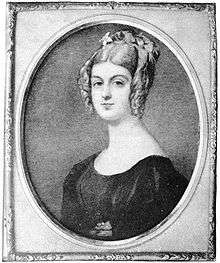Georgiana Molloy
| Georgiana Molloy | |
|---|---|
 Georgiana Molloy, taken from a miniature painted before she left England in 1829 | |
| Born |
23 May 1805 Cumberland, England |
| Died |
8 April 1843 (aged 37) Busselton, Western Australia |
| Fields | |
Georgiana Molloy (23 May 1805 – 8 April 1843) was an early settler in Western Australia, who is remembered as one of the first botanical collectors in the colony.
Georgiana Molloy was born Georgiana Kennedy in Cumberland on 23 May 1805. In her youth she was caught up in the Christian revival sparked by the preacher Edward Irving but implemented in a milder manner by Rev. Story of Rosneath. She became deeply religious, as was common for the educated class. She became distant from her own family in both sentiment and geography when she went to stay in Scotland with the Dunlop family at Keppoch House, near Helensburgh. Early in 1829, she accepted a marriage proposal from Captain John Molloy, and they were married on 6 August of that year. Shortly afterwards, the Molloys sailed for the Swan River Colony in Western Australia on board the Warrior. The couple then decided to join with a number of other settlers in forming a new subcolony at Augusta.
Until 1836, Georgiana Molloy's life was one of great hardship, typical of early settlers in Western Australia but unfamiliar to one of her social class in England. The trials of a settler's life were relentless and Georgiana birthed her first and most of her subsequent babies without medical assistance. She lost her first child shortly after birth and later her only son drowned in a well. She was vigorous in body, mind and soul and applied herself to the subsistence life. Initially she felt disdain for the local native flora. However, in December 1836, she received a letter from Captain James Mangles, asking her to collect botanical specimens for him. This letter was to fire in Georgiana a great passion for botany. Thereafter, together with her husband John Molloy, she spent nearly all of her leisure time in collecting, collating and documenting botanical specimens of the South West of Western Australia. This area is considered one of the 25 hotspots for biodiversity in the world.
Mangles had arranged for a number of people in the colony to collect specimens for him, but had been disappointed with the results. The specimens sent by James Drummond, a professional botanist, were poorly packed and carelessly labelled, and seeds consistently failed to germinate. Other collectors were more careful but largely unskilled. In contrast, Molloy's collections were "full of pressed plants mounted and set out with delicacy and precision, and carefully numbered... showing great evidence of care and cleanliness in the sorting" (Hasluck 1955). Mangles broke up Molloy's collections, sending seeds to a number of horticulturists and botanists throughout England. A number of horticulturists had great success growing from Molloy's seeds, and many new species were described. John Lindley, Professor of Botany at University College London, for example, described many new species from her collections, including Corymbia calophylla.
In 1839 the Molloy family moved to the Vasse district. Georgiana Molloy was visited by botanists Ludwig Preiss in 1839 and Drummond in 1842. She continued to collect seed, making use of the knowledge of the local Indigenous Australians, and she taught herself the rudiments of botany from books sent to her by Mangles.
Georgiana Molloy suffered bouts of ill health after each of her pregnancies. Following the birth of her seventh child, she fell ill and failed to recover. On 8 April 1843, three months after the birth, she died. On hearing of her death, George Hailes, a horticulturist who had been most successful in growing from Molloy's seeds, wrote to Mangles
Not one in ten thousand who go out into distant lands has done what she did for the Gardens of her Native Country, and we have indeed as regards her specially to lament, that "From Life's rosy Chaplet, the Gems drop away."
Molloy did not receive much recognition for her contributions to the description of the Western Australian flora. The shrub Boronia molloyae was named in her honour, as was a street in the Canberra suburb of Cook. Molloy island, also named after her, is located at the junction of the Blackwood and Scott Rivers 4 km north of the mouth of the Blackwood River at Augusta. The Bussell Highway links Busselton to Augusta. Distance from Augusta to Margaret River is 42 km and 90 km to Busselton. Her collections, which are kept at the Kew Herbarium and the University of Cambridge Herbarium, are attributed to Mangles. She has a school (Georgiana Molloy Anglican School) named after her in the town of Busselton, Western Australia. Three biographical books have been published; "Georgiana Molloy, Portrait with Background" by Alexandra Hasluck; An All Consuming Passion: Origins, Modernity and the Australian Life of Georgiana Molloy by William J. Lines and, most recently, "Georgiana Molloy, the mind that shines" by Bernice Barry.
Georgiana Molloy wrote a number of diaries and many letters which have provided a unique personal narrative. They are held at the Battye Library in Perth, Western Australia and the Cumbria Archive Centre in Carlisle, UK. Many of her letters are cross-written due to the shortage of paper in the isolated colony of Augusta.
References
- Barry, Bernice (2015). Georgiana Molloy: the mind that shines. Redgate Consultants. ISBN 978-0-9942064-0-4.
- Barry, Bernice (2016). Georgiana Molloy: the mind that shines. Picador. ISBN 978-1-7435491-4-8
- Hasluck, Alexandra (1955). Portrait with Background: A Life of Georgiana Molloy. Melbourne: Oxford University Press.
- Patrick, S. (2002). "Georgiana Molloy, a remarkable woman". Landscope. 17 (3): 43–48.
Further reading
There are many online sources including: www.georgianamolloy.com (linked to the research of her biographer Bernice Barry) and www.georgianamolloy.com.au. as well as several Facebook pages.
- Lines, W.J. (1994). An All Consuming Passion: Origins, Modernity, and the Australian Life of Georgiana Molloy. University of California Press. ISBN 0-520-20422-0.